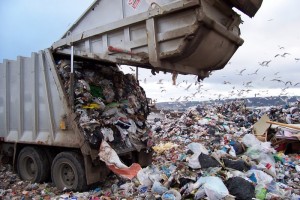
Trash tends to be a bit of the underdog of environmental concern these days. Perhaps that is because we think of the issues of trash to be limited to water and air quality problems arising from toxins leaking from landfills and dioxins and other poisons pumped into the air by incinerators (both of which are plenty bad enough).
But the trash issue is not just limited to the problem of disposing with our refuse–it is much larger. The fact that we have so much trash–4.5 pounds per person per day–points to the fact of how many resources we waste.
And what concerns me more than the waste of stuff that goes from my apartment to the downstream landfill is the waste of the upstream resources (the energy, the materials, the natural resources, the labor) used or destroyed to produce stuff I was planning to throw away anyway. For example, for every pound of trash I throw away, 70 pounds of materials were trashed during its manufacture.
It is as though the raw materials are dug out of one hole in the ground–a mine or an oil well–only to be transferred to another hole in the ground–a landfill–with a very short stop at my house in between. Indeed, in 2006, according to the Environmental Protection Agency, some 28% of our our municipal waste, by weight, was packaging and containers.
Does that mean 28% of the material, the cost, the labor and greenhouse gases associated with manufacturing can be attributed to packaging and containers we didn’t even want, that we throw away the first chance we get? The math, I’m sure, is not that straight forward, but you get my point.
If what we threw away was stuff that we actually had enjoyed and used and cherished, that would be one thing. But actually, much of what I found in my trash, after I saved it for a week and dug through it, was not stuff I cared remotely about.
Not only that, it was stuff I actively didn’t want in my or my family’s life. My trash, mostly, was the detritus of ordering and eating a lot of take out food. It was sesame noodle and stir-fried spinach covered plastic tubs, unused plastic utensils, paper napkins, plastic bags and–oh yeah–baby diapers.
The diapers we’ll talk about another time, but what I discovered in my trash when I saw the mountain of greasy plastic tubs was a life I didn’t want, a life in the trash. We didn’t want to eat unhealthy take out food every night. It wasn’t good for our bodies or our wallets. Nor did we like the rushing lives around which all this take-out trash seemed to revolve.
In other words, the trash in our apartment was the worst kind of waste because it was, really, stuff we didn’t want in the first place. And that’s where eliminating trash started in the No Impact project. We started by eliminating the activities we didn’t even want in our lives that produced waste. We started home cooking fresh food.
In other words, from the very get-go, the No Impact project was about happier planet, happier people. Far from depriving ourselves, reducing waste in our lives would move us closer to rather than farther from the lives we actually wanted.
Personal lifestyle tip #1 in the LV GRN series: If you want an easy and life-enhancing way to reduce the trash you create and the resources you waste, save your trash for a week. Then, go through and see what the biggest amounts of trash are caused by (take out for me). Are there any sources of trash in there that don’t even make you happy? Choose one and eliminate it.
Make a comment by clicking below and let me know what you find out.
And just as interestingly, are there areas at the cultural or structural level where we could eliminate materials waste and end up improving the lives of our citizens? Put your thinking cap on. Be specific. Let me know what you find out about that, too.
PS The next few posts in the LV GRN series, when they come, will be about eliminating material waste on both the personal and cultural levels.